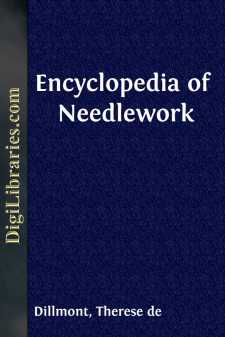Categories
- Antiques & Collectibles 13
- Architecture 36
- Art 48
- Bibles 22
- Biography & Autobiography 813
- Body, Mind & Spirit 142
- Business & Economics 28
- Children's Books 15
- Children's Fiction 12
- Computers 4
- Cooking 94
- Crafts & Hobbies 4
- Drama 346
- Education 46
- Family & Relationships 57
- Fiction 11828
- Games 19
- Gardening 17
- Health & Fitness 34
- History 1377
- House & Home 1
- Humor 147
- Juvenile Fiction 1873
- Juvenile Nonfiction 202
- Language Arts & Disciplines 88
- Law 16
- Literary Collections 686
- Literary Criticism 179
- Mathematics 13
- Medical 41
- Music 40
- Nature 179
- Non-Classifiable 1768
- Performing Arts 7
- Periodicals 1453
- Philosophy 64
- Photography 2
- Poetry 896
- Political Science 203
- Psychology 42
- Reference 154
- Religion 513
- Science 126
- Self-Help 84
- Social Science 81
- Sports & Recreation 34
- Study Aids 3
- Technology & Engineering 59
- Transportation 23
- Travel 463
- True Crime 29
Encyclopedia of Needlework
Categories:
Description:
Excerpt
Plain Sewing.
Many, on opening the Encyclopedia of needlework will be disposed to exclaim as they read the heading of this first section: What is the use of describing all the old well-known stitches, when machines have so nearly superseded the slower process of hand-sewing? To this our reply is that, of all kinds of needlework, Plain Sewing needs to be most thoroughly learned, as being the foundation of all. Those who are able to employ others to work for them, should at least know how to distinguish good work from bad, and those who are in less fortunate circumstances, have to be taught how to work for themselves.
Position of the body and hands.—Before describing different kinds of stitches, a word should be said as to the position of the body and hands when at work. Long experience has convinced me that no kind of needlework necessitates a stooping or cramped attitude. To obviate which, see that your chair and table suit each other in height, and that you so hold your work as hardly to need to bend your head at all. The practice of fastening the work to the knee, besides being ungraceful, is injurious to the health.
Needles.—These should be of the best quality. To test a needle, try to break it; if it resist, and then break clean in two, the steel is good; if it bend without breaking, or break without any resistance, it is bad. Never use a bent needle, it makes ugly and irregular stitches, and see that the eye, whether round or egg-shaped, be well-drilled, that it may not fray or cut the thread. Long or half-long needles are the best for white work, long ones for dress-making, and longer ones still, with long eyes, for darning. A stock of each, from No 5 to 12, is advised. The needle should always be a little thicker than the thread, to make an easy passage for it through the stuff.
To keep needles from rusting, strew a little stone alum in the packets, and workers whose hands are apt to get damp, should have a small box of it handy, to powder their fingers with. Blackened needles can be made quite bright again by drawing them through an emery cushion.
Scissors.—Scissors are a very important accessory of the work-table, and two varieties are indispensable; a pair of large ones for cutting-out, with one point blunt and the other sharp, the latter to be always held downwards; and a pair of smaller ones with two sharp points. The handles should be large and round; if at all tight, they tire and disfigure the hand.
Thimble.—Steel thimbles are the best; bone are very liable to break, and silver ones are not deeply enough pitted, to hold the needle. A thimble should be light, with a rounded top and flat rim.
The thread.—Except for tacking, your thread should never be more than from 40 to 50 c/m. long. If the thread is in skeins, it does not matter which end you begin with, but if you use reeled cotton, thread your needle with the end that points to the reel, when you cut it; as the other end will split, and unravel, when twisted from left to right, which is generally done, to facilitate the process of threading. The cotton should always be cut, as it is weakened by breaking.
Knotting the thread into the needle (fig. ).—When the thread becomes inconveniently short, and you do not want take a fresh one, it may be knotted into the needle, thus: bring it round the forefinger close to the needle, cross it on the inside next to the finger, hold the crossed threads fast, with the thumb draw the needle out through the loop thus formed, and tighten the loop round both ends.
Fig. 1. Knotting the thread into the needle.Materials.—For tacking, use Coton à coudre D.M.C qualité supérieure (black and gold stamp) Nos. 2 to 6. For hand-sewing, Fil d'Alsace D.M.C Nos. 30 to 700, and Fil à dentelle D.M.C, balls or reels, Nos. 25 to 100 will be found most useful. For machine-work: Câblé 6 fils pour machines D.M.C, Nos. 30 to 300, black and white, or white and blue stamp. These can also be used for hand-work. Both these and the lace-thread (Fil à dentelle) on reels, are superfine in quality. The medium sizes are the most useful; but the only suitable ones for very fine and delicate fabrics are the Fil à dentelle D.M.C, and Fil d'Alsace, and the latter only is manufactured in the higher numbers....


